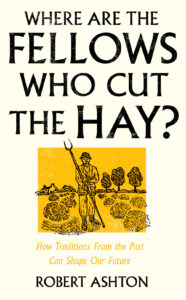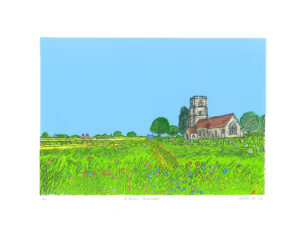Inspired by George Ewart Evans’s ‘Ask the Fellows Who Cut the Hay’, Robert Ashton’s ‘Where Are the Fellows Who Cut the Hay?’, published tomorrow by Unbound, is an ode to rural life — charting traditions of the past, how they were lost and why we need to reconnect. Read an extract below.

Often I would ride with Michael in his grey Bedford van when he went to the hotels in Aldeburgh to collect dustbins full of swill, the scraps that we would feed to the pigs he was fattening on contract for Wall’s. The van had sliding front doors and a three-speed column gear-change. There was only a driver’s seat, so any passengers sat on a grain sack placed upon an upturned wooden crate. In those days, seat belts were fitted but rarely worn.
The pigs were fattened in an open yard between the barn and other outbuildings. Pigs will eat anything, and noisily enjoyed the swill we collected from local hotels and schools each morning. At each stop, full dustbins would be replaced with scrubbed-out empty ones from the day before. They were battered, metal bins and quite heavy when full. We would unload the van and tip the swill straight over the wall onto the concrete apron that edged the pig yard. We were supposed to boil it first, but rarely bothered. In fact, the boiler was only lit when a Wall’s inspector was calling. The pigs would start screaming excitedly and running around as soon as they heard the van approaching. I don’t think a crowded football stadium can generate the same volume of noise as sixty hungry pigs when they know they’re about to be fed. Watching them jostling and devouring the scrapings from hotel guests’ plates was always interesting. Pigs are intelligent and I think would listen out for the van and be in position by the wall even before it pulled into the farmyard. As I was the bank manager’s son, I was always invited into the house for lunch on the days I was at the farm. All of the knives, forks and spoons on the table bore the Trusthouse Forte logo. They had been salvaged from the pigswell and recycled. Nothing went to waste in those days. Other people had to pay to eat their food with hotel cutlery; we did it every day, without ever paying a penny. Farmers are always frugal, preferring not to waste anything, so using discarded cutlery was as logical as sitting on an upturned crate in the van rather than buying a van with a passenger seat.
Later, when I passed my driving test, I was allowed to collect the swill on my own. This became a weekly Saturday adventure. I loved driving the old van to Aldeburgh on a summer’s morning with both front doors open. If I floored the accelerator, it might just reach seventy, but only when going downhill. There aren’t many hills in Suffolk! Soon I was working on other farms too. With Mike and Des Newson, identical twins who farmed behind the church at Aldringham, and also on Blackheath Estate at Park Farm, Friston, where I learned to milk Jersey cows. Unlike Michael’s pigs, which were clamorous and boisterous, focused only on their stomachs, I found the cows to be far gentler and more capable of showing affection.
I would cycle over to help Fred the cowman, and after a few months was trusted to milk the cows alone when Fred had his day off. I came to learn the pecking order which dictated which cows would appear in the cowshed first and over time realised that each also had a different personality. One in particular I’d had to hand milk as she had torn a teat on barbed wire. I’d do this gently, and then apply antibiotic cream to the wound afterwards to help it heal. I like to think she remembered this kindness and would come over to be stroked whenever I was out in the fields, calling the cows in to be milked.
The cowman on Blackheath Estate was the first farm worker I really got to know. Unlike Michael, he was not his own boss, but one of the many men working on a large estate. I remember being surprised by how readily he deferred to the farm manager, from whom he would accept orders without question. Getting to know Fred gave me an insight into the lifestyle and attitudes of people like those that George Ewart Evans wrote about in Ask the Fellows and his other books.

Image: John Richardson
Fred and his wife and daughter occupied a tied cottage by the road at the top of the farm drive. In the cottage next door lived Clive, a younger man, who drove a tractor and sometimes also helped with the cows. Later Clive worked for Henry Green field at Leiston, and then for himself, with a smallholding at Common Farm. This was as close as most ever got to farming in their own right as land then, as now, was prohibitively expensive and so out of reach. Fred was thin, but strong in a sinewy way. His life was shaped by his diabetes, so he would break off from milking to eat a couple of biscuits if he felt his blood sugar level was becoming dangerously low. His wife was as fat as Fred was thin – not obese, just well-rounded and jolly. They had a daughter, Cindy, and Fred also had a lady friend in Ipswich he visited each week on his one day away from the farm. Being a teenager, I used to assume that Fred was enjoying a wild romance on his days off that his wife tolerated to keep the family together, but I may have been completely mistaken. But I can still see him in my mind’s eye, in his pale-blue Austin A40 Farina, freshly shaved and wearing his blue beret, nosing the car out of the farmyard gate down the road towards Ipswich.
Most of the farmworkers had been there for generations. Sons almost always joined their fathers on the estate and daughters either entered service in the big house or worked casually on the farms until they married. Nobody moved far and it came as no surprise when reading Ask the Fellows to learn that of the 250 people living in Blaxhall in the 1950s, one in five had the family name Ling. There were Lings working on Blackheath Estate too, who I am sure were related as Blaxhall was just five miles away.
It was while working at Blackheath Estate that I discovered George Ewart Evans. Ask the Fellows Who Cut the Hay was the first of his books that I read. It had been written perhaps fifteen years earlier and, because I knew the area so well, really captivated me. So much of what I had experienced fell into place when I read his books. It gave me a sense of belonging, and perhaps context, which I think had previously been missing in my life. I was after all a bank manager’s son, with all the opportunities middle-class life has to offer. Those who lived and worked on the farms seemed to be content to have little, travel little and expected nothing more than that things would continue as they were. But things were changing and, in many ways, what in the 1950s had been a gentle evolution, by the 1970s had become a rapid transformation that could never be reversed. When I turned nineteen, I went to agricultural college and then spent ten years selling fertiliser to farmers. Here again I came to know people who lived very similar lives to those I knew in Suffolk. Norfolk, where I first worked, also had a mix of large country estates and small family farms. In those days, the agricultural merchants I worked with were mostly family firms, but over my decade in the agricultural supply industry those small companies were gradually replaced by international grain-trading operations, with their own ships. Later in my career I sold mobile homes, and then following redundancy spend thirty years working for myself, helping charities and social enterprises grow their income.
I still visit Michael, the farmer who brought my chicken shed over and gave me a weekend job. He has been my father-in-law now for more than forty years. He retired a few years ago and the farm he rented is now cropped by contractors, working for the estate of which it always formed a part. I became part of the rural Suffolk landscape that Evans wrote about so well. I realised that morning, sitting in the silence of the Quaker Meeting House, that as my own retirement approaches, it is perhaps time to revisit rural Suffolk and my past, and explore how our past might help us shape our future.
*
‘Where Are the Fellows Who Cut the Hay?’ is out tomorrow. Buy a copy here (£16.14).